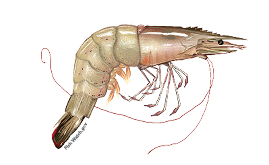Consumption Advice
There is no consumption advisory for Wisconsin farm-raised shrimp.
Taste and Nutrition
Pacific white shrimp are popular because they have a clean, sweet taste with a classic shrimp flavor and firm texture. They are bluish-gray or greenish-gray when raw but turn pink when cooked. While all shrimp have more cholesterol than other types of seafood, they are lower in total and saturated fat than most meat and poultry.


